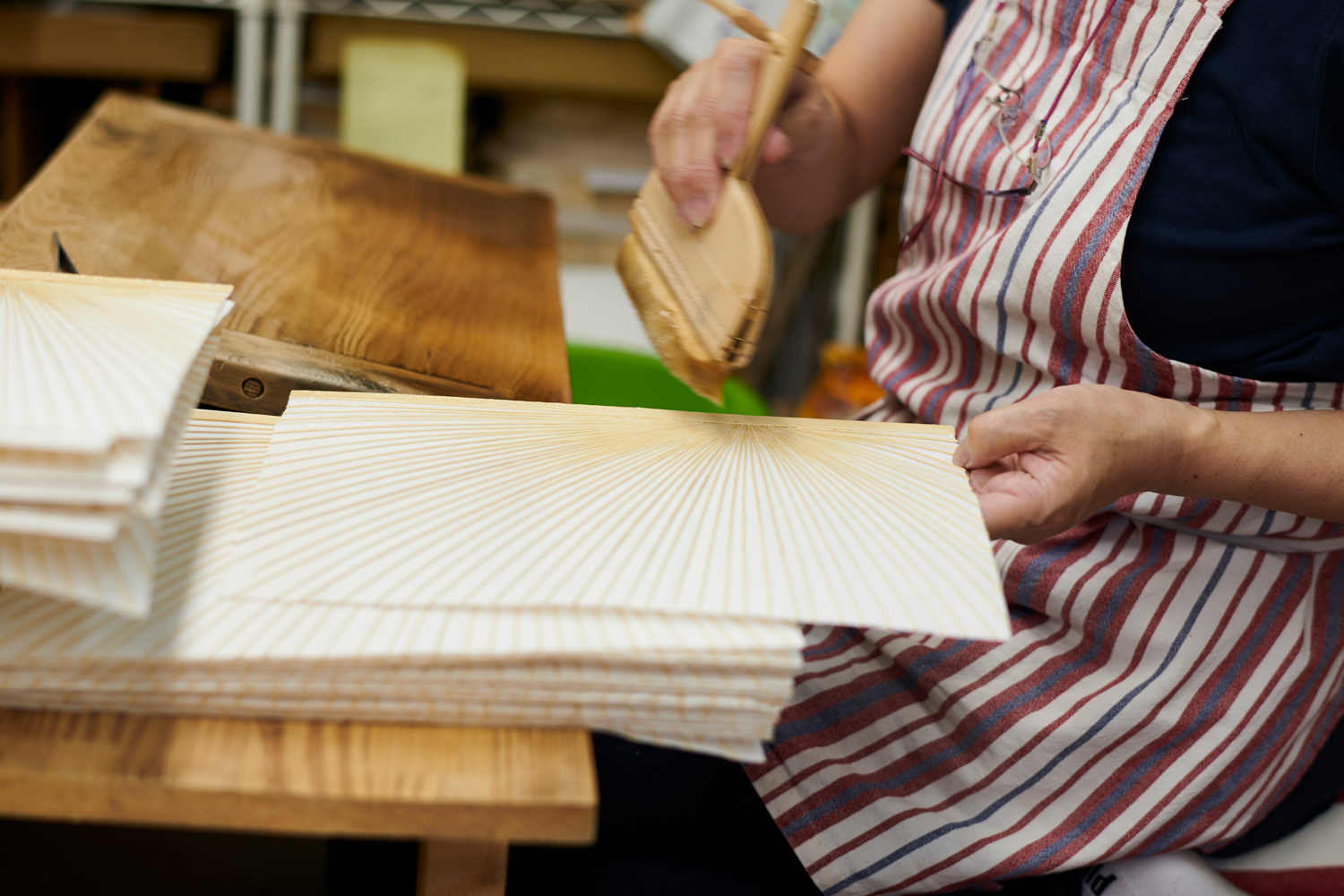A journey where a craftsman meets a craftsman







Shiomi fan co. Ltd / Akita Yoshikatsu Kyoto
« Kyo-uchiwa » a fan refined in the noble court of Kyoto
with a history of 300 years
A fan , "Uchiwa" in Japanese, is mainly used for a fresh breeze though in ancient times, people of high rank used to hide their faces behind. For the ordinary people in Japan, the uchiwa became indispensable tool in daily life to keep cool on a hot day or to build a fire.
The "Kyo-Yasugi" fan was used as a personal object by the court nobles in Kyoto after the Edo period (1603-1867). This handcrafted elegant fan cannot be compared with any industrially made products.
The long-established Shiomi Fan Workshop, located in Yamashina, Kyoto, has inherited this tradition.
The company's origins go back to the 1940 when the first generation of fan-makers arrived in Kyoto from Ayabe. We asked Mr. Yoshikatsu Akita, the current head of the company, about the history of the Kyoto Uchiwa .
“Kyoto fans are said to have a history of about 300 years. In contrast to Edo, where the shogunate was located, Kyoto was home to the imperial palace and very sophisticated crafts such as the Nishijin textiles, bamboo, wood, lacquer, and fusuma (painted sliding panels). In consequence, the fans also became rather sophisticated utensils.”
The fans used at court were sometimes given by the emperor as a prize or gift. These fans, decorated by skilled craftsmen (painters, lacquerers or carvers), were called "Gosho Uchiwa" (imperial court fans) and highly prized as decorative items for the throne room.
A beautiful object created from bamboo, Japanese paper, cedar
The »Kyo-Uchiwa » structure is made of madake bamboo strips and Japanese paper but the pattern consists of moso bamboo, cedar and lacquer. In other words, the structure and the pattern are separate. Currently, only the fans made in Japan using domestically produced materials can call themselves "Kyo-Uchiwa". The madake bamboo is cut in winter and then split into strips.
“The bamboo splitting can only be done in winter, when the bamboo has less moisture and is tighter. The bamboo is shredded with the joints removed, and then chopped into thin strips. The fibers split and fall apart when the bamboo is rubbed by hand. The final step is to shave down the strips to half their thickness.”
Once this has been done, the bamboo strips are cut one by one and placed on a temporary pasting paper in a radial pattern. The skill of the craftsman lies in arranging them evenly and neatly without any guidelines. In Kyoto, only the parts between the nodes of the bamboo are used, resulting in a flat, delicate structure.
"The flatness of the Kyoto folding fans is considered to be their characteristic. The basic idea is to show the beauty of the bamboo frame. A thin layer of adhesive is spread on a board, and then the adhesive is applied to the bamboo frame. Since the cross-section of the bamboo frame is square, the adhesive is applied only to one side. Then the Japanese paper for the upper design is attached. If the adhesive is applied to the entire surface of the Japanese paper, it would become heavy and lose its flexibility.""
Once the fan has been glazed and painted, the folding fan undergoes a process called "Nenzuke," where clean grooves are made along the bamboo frame. Afterward, a rimmed paper (herigami) is attached to finish the surface of the fan. Finally, a handle is fixed and the fan is completed. In the past, there were specialized craftsmen for splitting the bamboo, attaching the bamboo frames, and making the handles, but in recent years, due to the aging of artisans and the increasing number of businesses closing down, the Shiomi Fan workshop had to take over those processes which can no longer be outsourced.
A collaboration that redefined the norms of folding fans: Working with a Designer
I had the opportunity to meet the representative, Mr. Akita, through the « Contemporary Kyoto » project that I produced. In 2018, Mr. Akita participated in the "Contemporary Kyoto NEXT» project which aimed to develop sales channels. Later on he became also interested in collaborative manufacturing with external designers and ventured into new product development in the following year.
"In the era when there were no electric fans or air conditioners, folding fans were truly essential items for daily life. However, nowadays they have become less commonly used due to the convenience of modern appliances. Since the time of my predecessors, we have been producing fans as novelty items, but I felt that this alone was reaching a dead end. We realized that it was necessary to preserve handcrafted folding fans that are recognized, appreciated and purchased for their true value."
The result of the first experience of working with an outside designer was a "square fan" that overturned the conventional norms of the traditional Japanese fan. Its uniqueness lies not only in its square shape but also in the asymmetrical arrangement of the bamboo frame, which, combined with the design of the upper image, created an effect similar to the "action lines" in a manga.
Furthermore, the handle obtained a circular shape, sublimating it to a minimalist style of only geometric shapes: round + square.

"It started with explaining to the designer who had no prior knowledge of folding fan making, saying, 'These are the materials and this is the manufacturing process.’ From there, we ventured into transforming the originally circular folding fan into a square shape, or turning the normally vertical alignment of the frames sideways… Ah, this is interesting,' I thought, even during the development phase."
Parallel to the "Kakuōgi" fan, another creation called "Yasai Uchiwa" was produced, which depicted Kyoto vegetables. This "design fan" can be held and used for cooling, or simply admired when placed on display. It injected a new breath of fresh air into Shiomi Uchiwa fans, offering a unique fusion of functionality and design.
A Second-Year Attempt rewarded with the "Best Craftsmanship Award" at the Tokyo Gift Show
In the following year, 2020, Mr. Akita participated again in the "Contemporary Kyoto" project. This time,
he collaborated with a designer on the theme of creating a folding fan that can be enjoyed as an interior decoration throughout the year. The new fan « Mori no Uchiwa », shaped like the silhouette of a tree, features delicate cut-outs resembling a tree trunks and showcases the beauty of the bamboo frame. It is designed to evoke the changing colors of trees throughout the four seasons. A notable feature is that the front and back sides are reversible with contrasting colors.
"We have also added a stand on which the fan can be placed for display. Interestingly, a few years ago, the manufacturer of the handles went out of business, so we had no choice but to invest in machinery and start producing the handles in-house. Having the materials and facilities in our own company allowed us the freedom to think and create various forms."
The "Mori no Uchiwa" was exhibited at the 2021 Tokyo Gift Show and impressively won the "Best Craftsmanship Award." It can be said that the spirit of the cherished "Gosho Uchiwa" fan from the Edo period has been successfully updated and revived for modern times.
Through the trials in the "Contemporary Kyoto" project, Mr. Akita has broadened his ideas, such as utilizing folding fans as wall decorations or lampshades. He recognizes the significant role that design can play in bridging the traditional Kyoto fan craftsmanship to the next generation.
"I still want to create something that can be admired and appreciated visually and tactilely. I want to continue thinking about how we can derive new ideas from the techniques of fan making".

